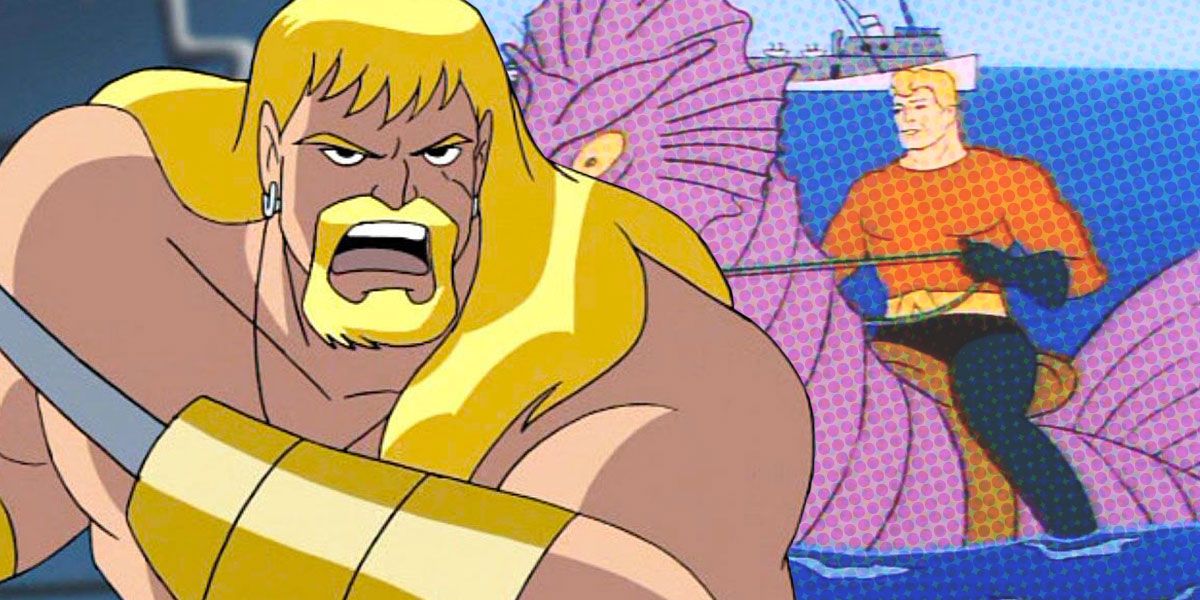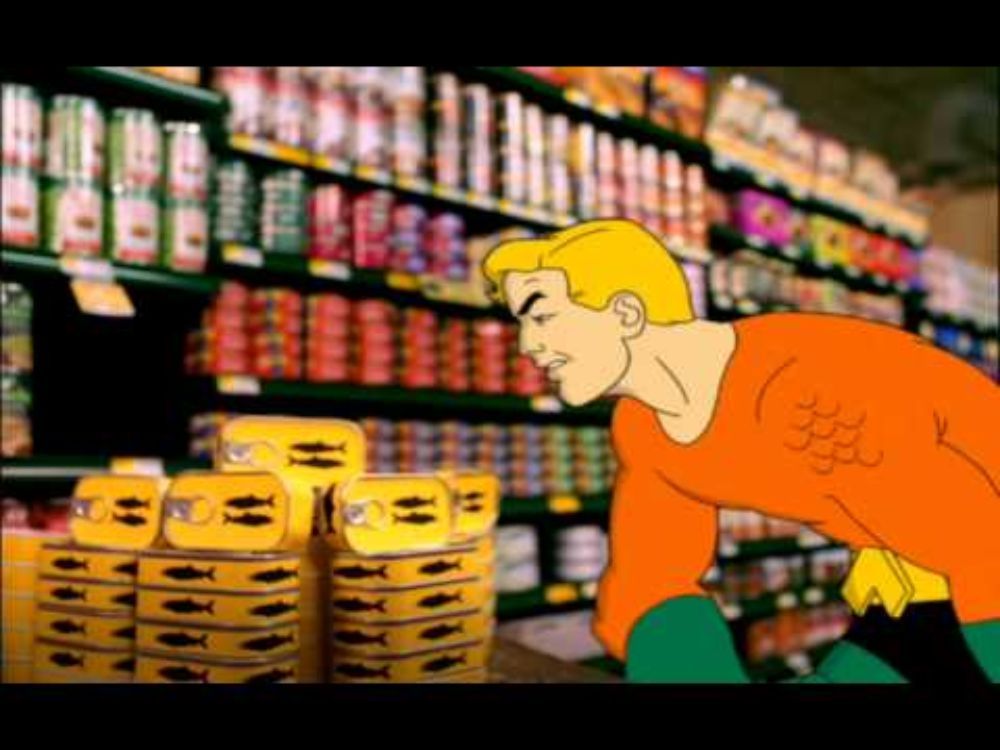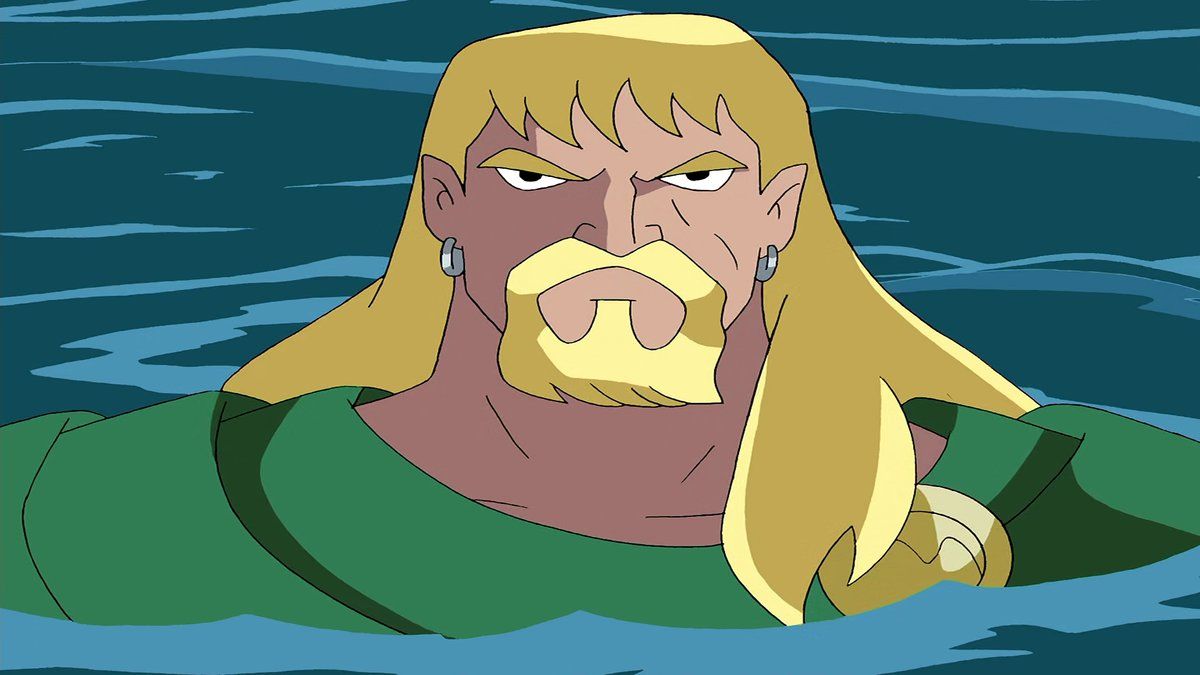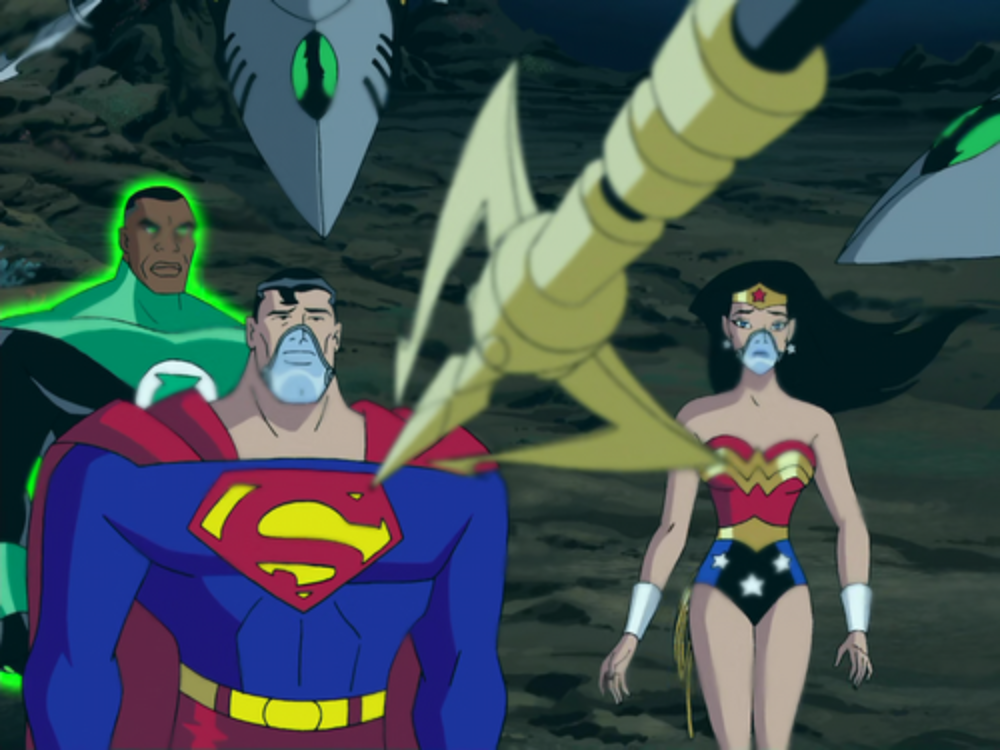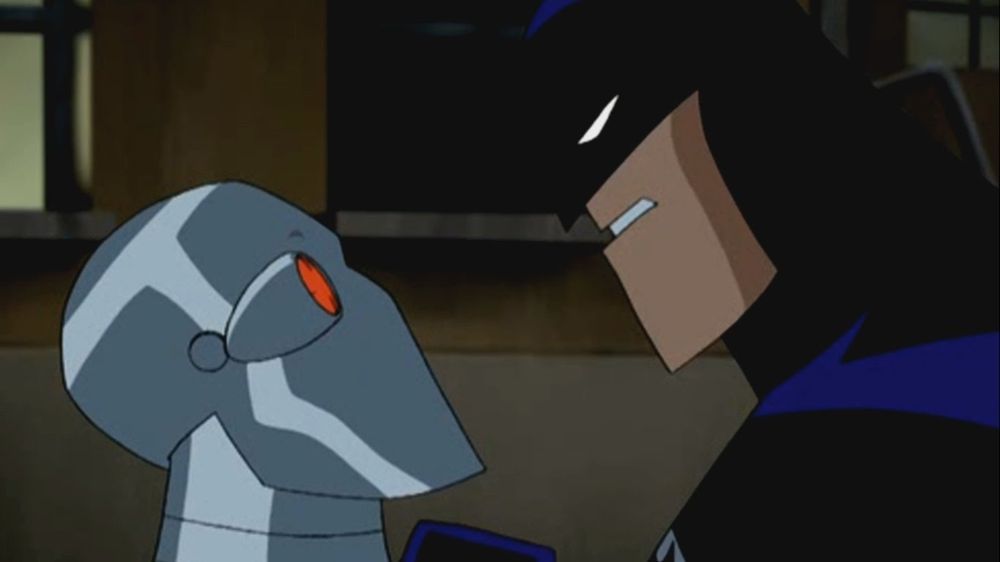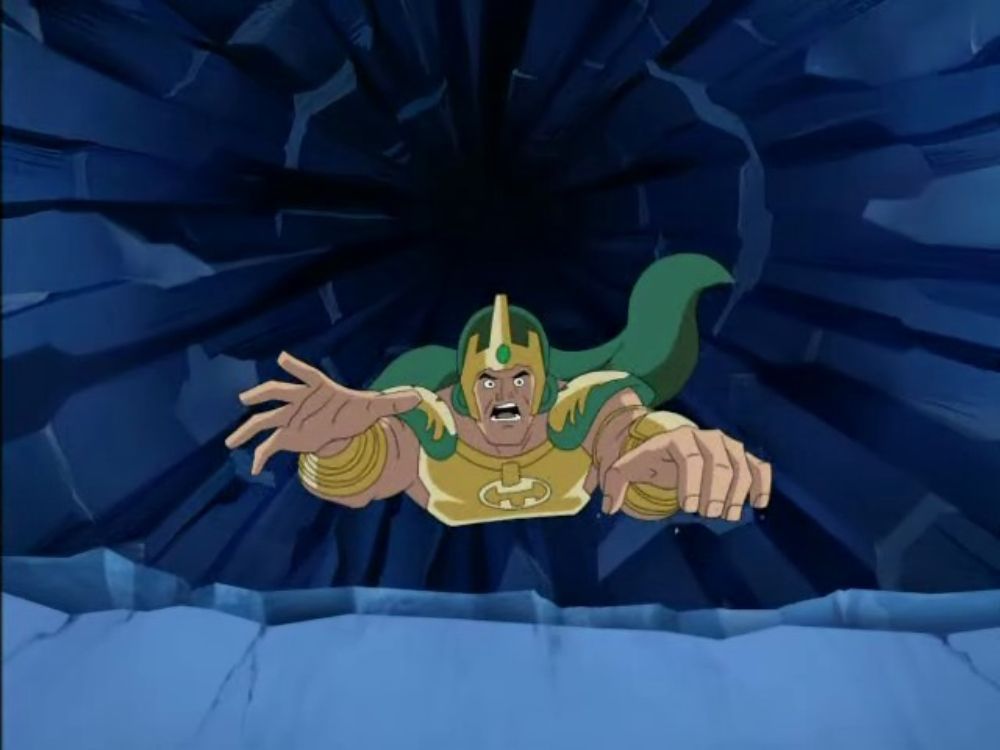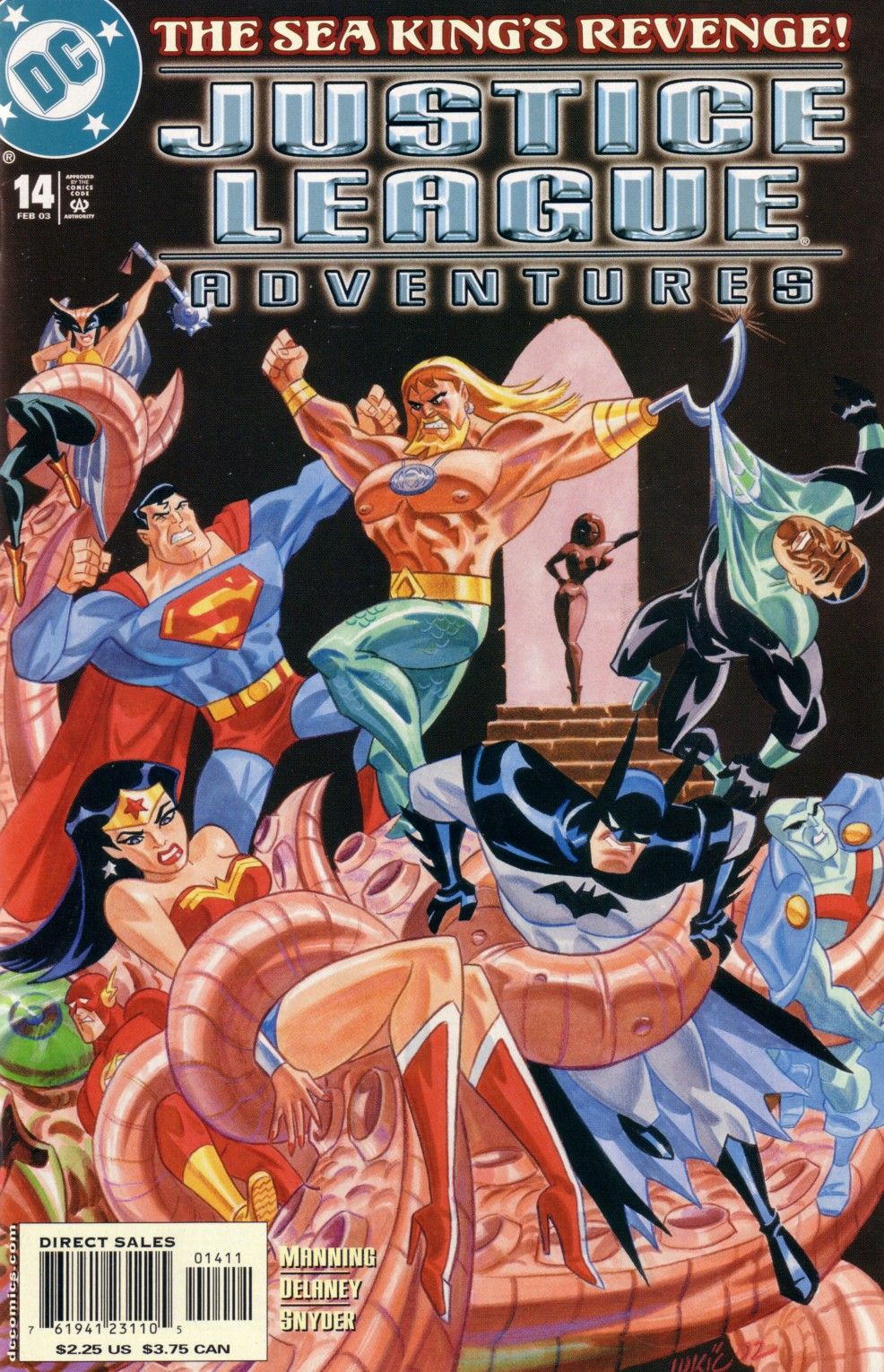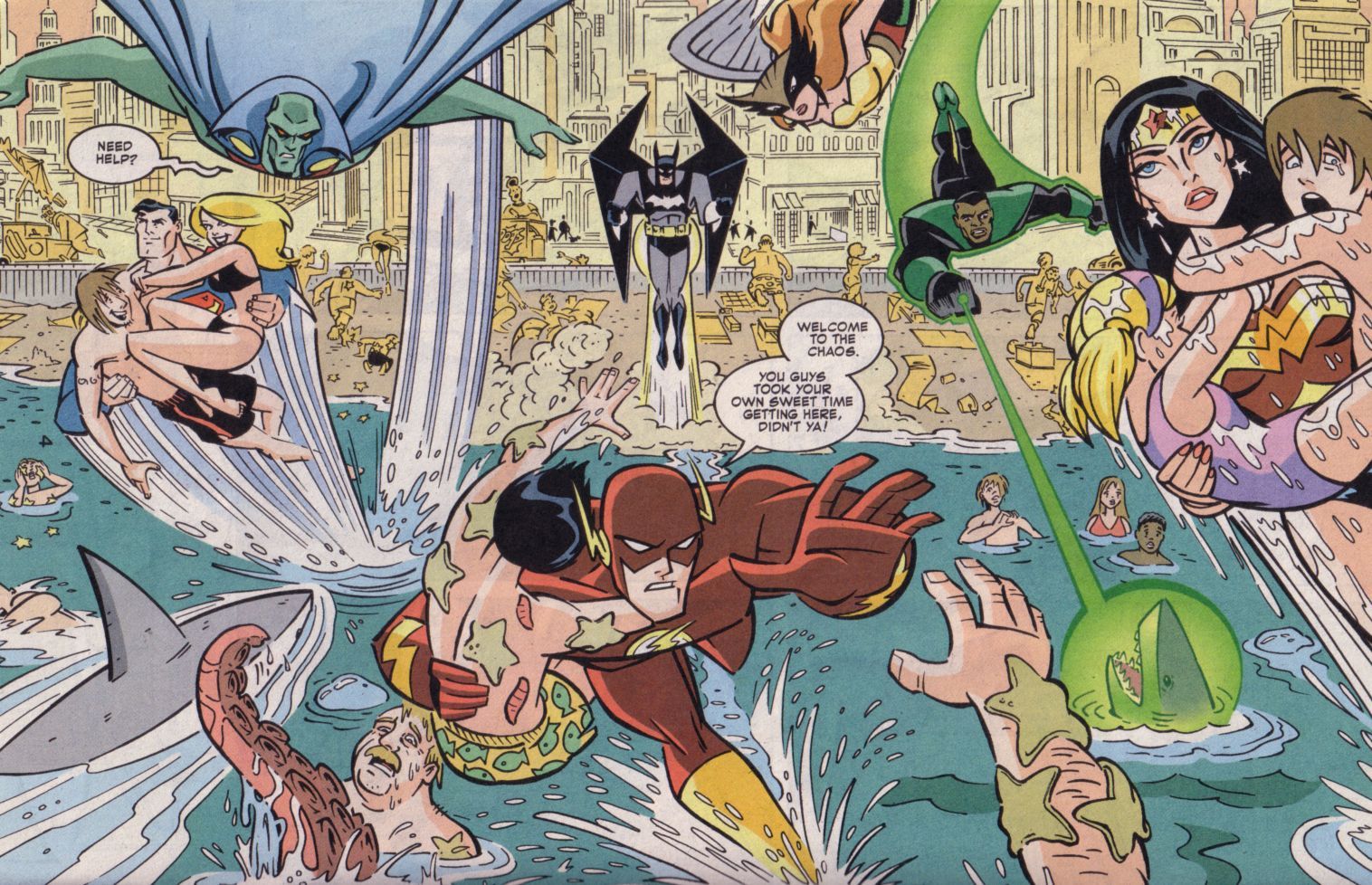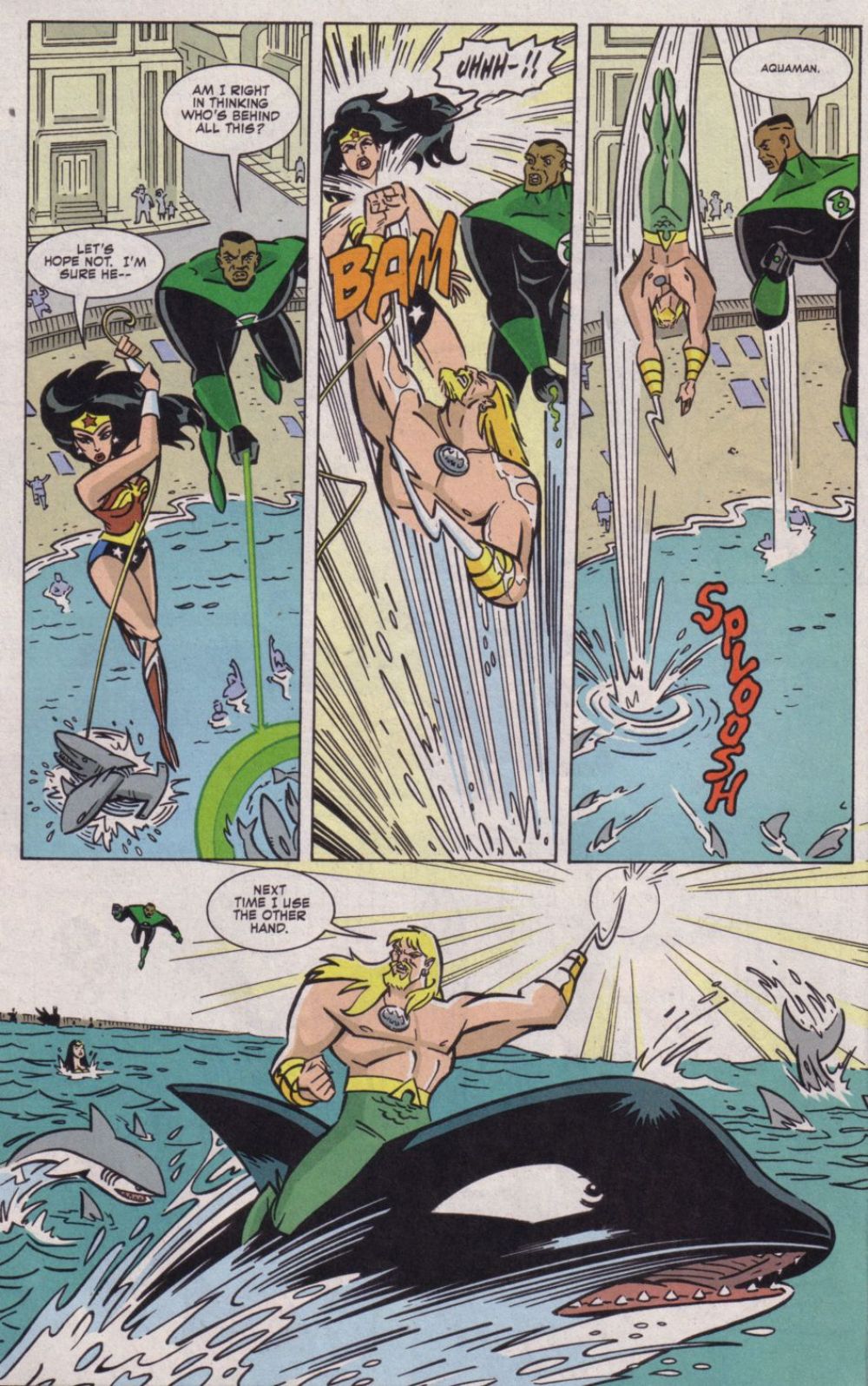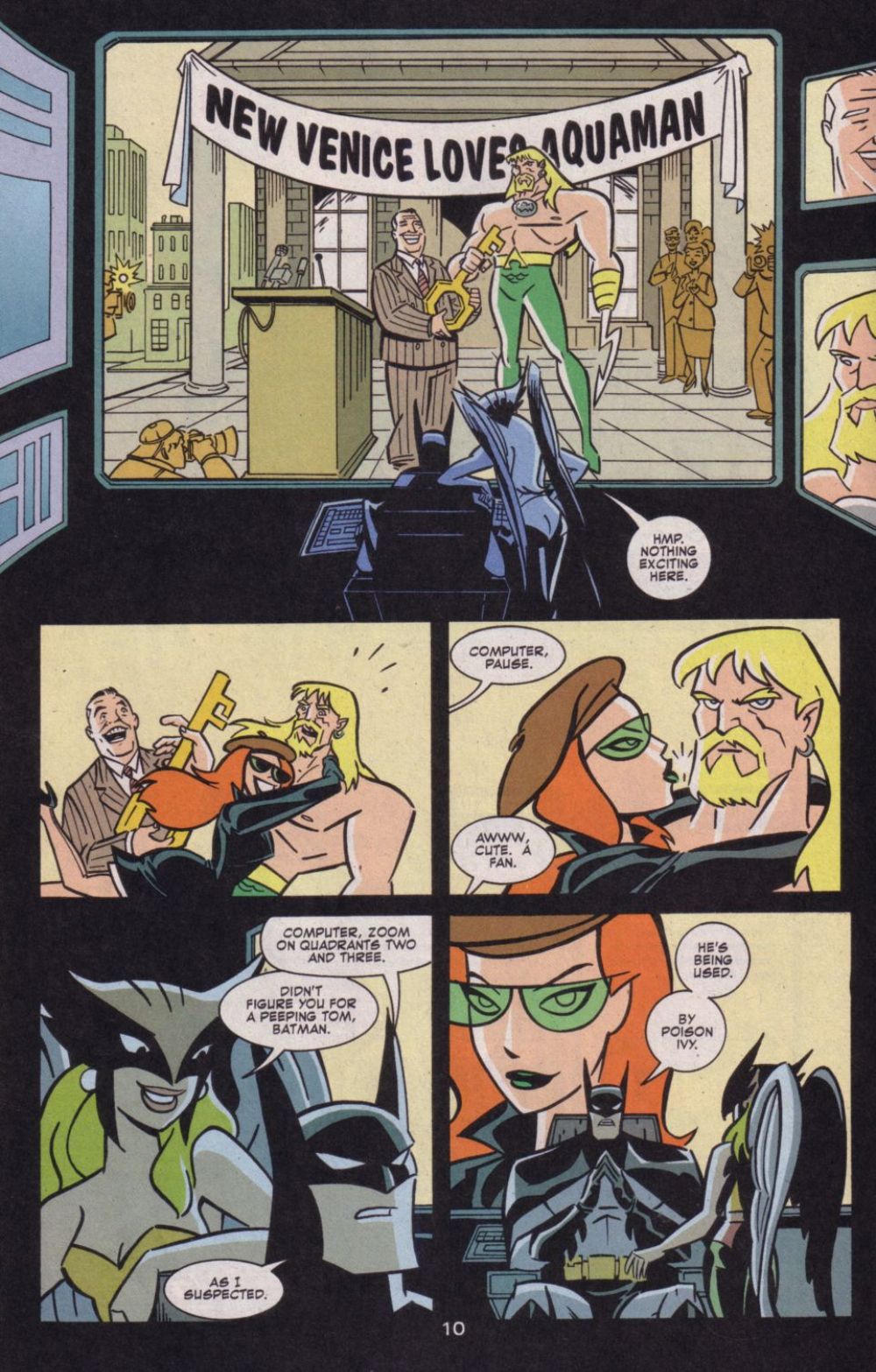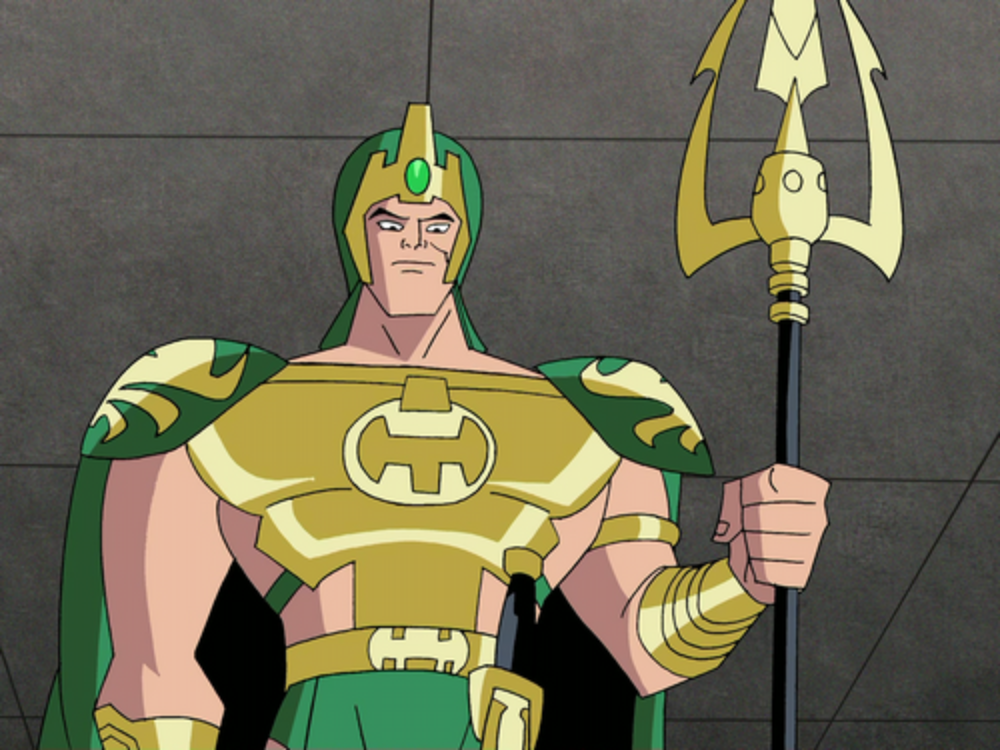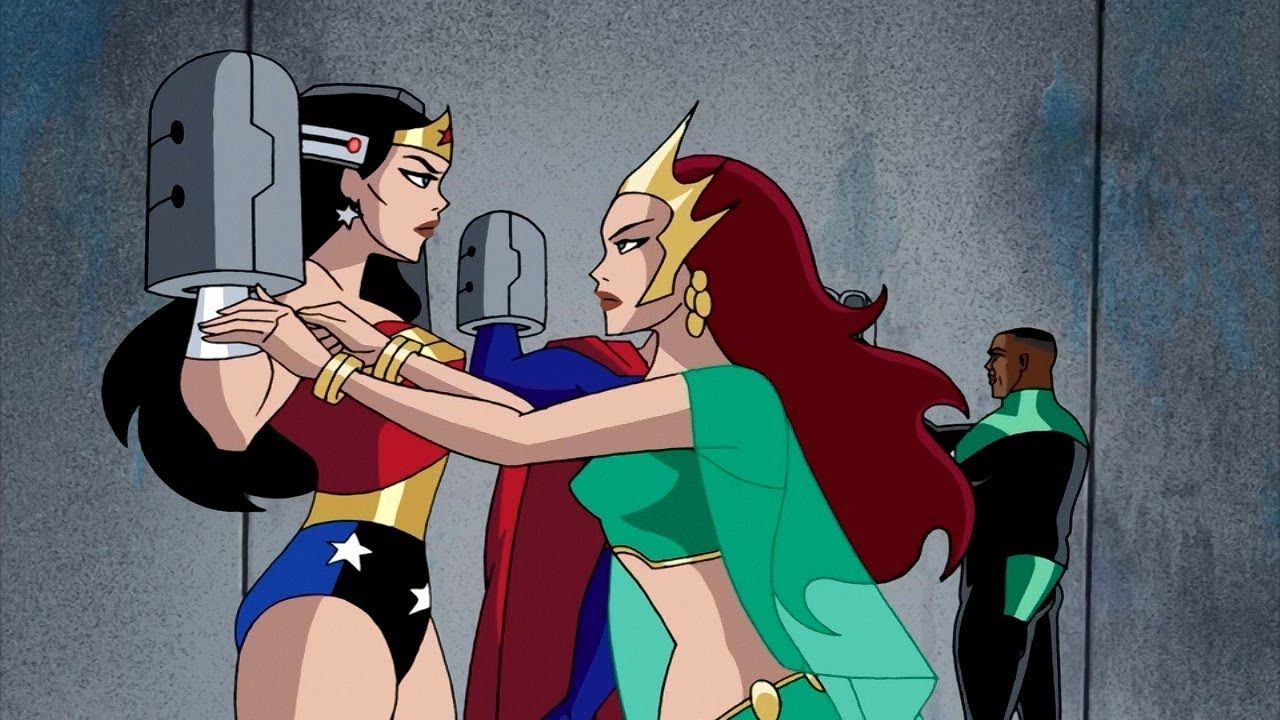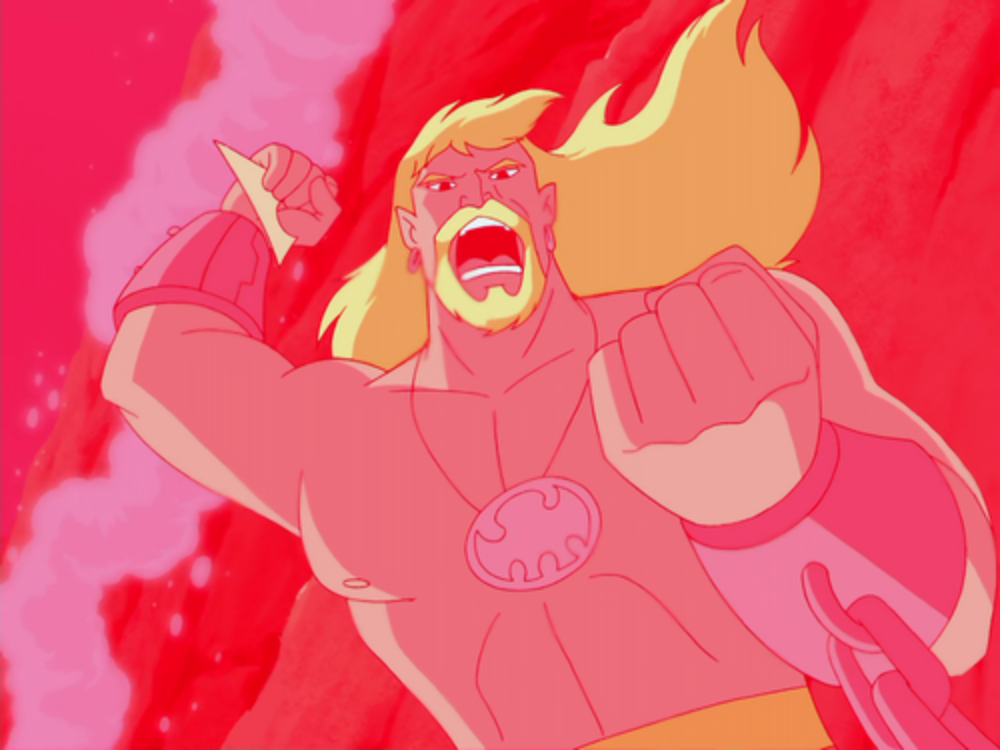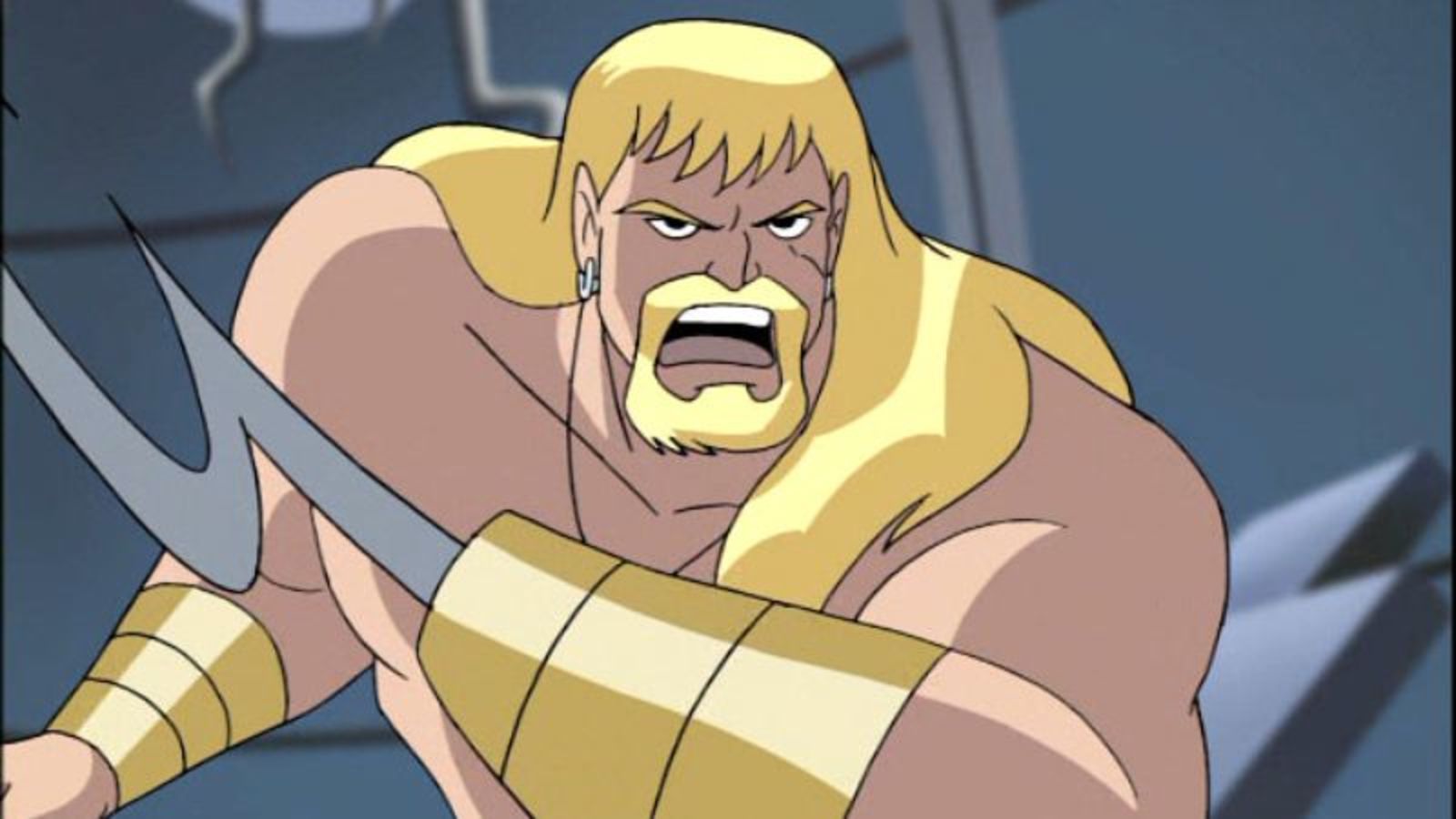Welcome to Adventure(s) Time's sixty-third installment, a look at animated heroes of the past. This week, we're revisiting the first time the animated Justice League deigned to feature "joke character" Aquaman. Then, a related story from the tie-in comic.
I'm not sure when the "Aquaman is lame" mantra began amongst fandom. (It predates the modern Internet, so it's not truly a "meme.") Wizard magazine, and its sister Toyfare, surely contributed to it. Cartoon Network, in the late '90s, likely made it mainstream with their Super Friends promos. Produced by the Williams Street crew now responsible for Adult Swim's programming, Aquaman was consistently the butt of the joke. "Hor! He talks to fish!" and all of that.
The hero's status as a punchline isn't the reason he wasn't selected as one of the seven Justice League regulars, but the producers acknowledge it played some role. When featuring him in the two-parter "The Enemy Below," written by Kevin Hopps and directed by Dan Riba, a conscious effort was made to distance Aquaman as far from Super Friends as possible. This Aquaman is King Arthur, the coldly pragmatic ruler of Atlantis. He's irritated by human interference in his land, opening the story by attacking a U.S. nuclear sub.
After initially presenting Arthur as a potential villain (his past with Superman only obliquely acknowledged), his character is fleshed out in subsequent scenes. He's a new father, fiercely protective of his wife Mera and their son. His brother, Orm, is actively advocating for a full-scale attack on the surface world, which he rejects.
RELATED: The Very (Very) Unusual Path Behind the Animated Justice League's Debut
While Arthur allows the Justice League to rescue the submarine crew, he does claim the sub's plutonium as his own. So, not strictly a villain, but not the "lame" Super Friends hero, either. He's now a cross between Namor and perhaps Conan, while still maintaining some of the classic Aquaman traits.
With Superman's encouragement, Arthur travels to the surface world to present Atlantis' case to an international conference, only to be attacked by Deadshot. Batman manages to devise the healing tank needed to spare Arthur's life, and intimidate Deadshot into turning on his employer. The unique payment of gold coins points to Orm as the culprit.
Arthur, now healed, discovers this independently upon returning home. Orm plots to use a lava fissure to kill both Arthur and Arthur, Jr., granting him a clear path to the throne. Arthur escapes the death trap, and rescues his son, by using his belt buckle to sever his left hand.
RELATED: A History of Kevin Conroy's Evolution as Batman
The Justice League, with Mera's help, escape another deathtrap. From there, they team with Arthur to stop Orm, and the Doomsday Thermal Reactor he's armed with the stolen plutonium. It's a fairly pat ending, complete with messages on teamwork and working together...with one exception.
Facing his brother in the Arctic Circle, Arthur is given an opportunity to save Orm from a fatal fall. He refuses, reaching for his ceremonial trident instead. Orm screams in horror, falling to his death. Not very pro-social, Aquaman!
NEXT PAGE: Aquaman's Modern Animated Justice League Debut... Was Not on the Show
Before Aquaman reappeared on the show, he popped up in the tie-in comic. Justice League Adventures #14 (February 2003) comes from writer Matthew K. Manning and artist John Delaney. "An Angry Tide" has Aquaman once again attacking the surface. He has a more reasonable excuse this time, however.
Behind the lovely painted cover by Butch Lukic, the story opens with attacks from various sea life in Gotham. Batman calls in the League's help, and unlike many Season One episodes, the entire team actually appears this time. Artist John Delaney is pretty divisive in DCAU fandom, but his rendition of the League is pretty strong here.
RELATED: Remembering the Animated Justice League Pilot (And Its Forgotten Sequel)
Not surprisingly, Aquaman reveals himself as the leader of the aquatic rebellion. The team is unable to apprehend him, and Flash even ends up in the hospital, following an encounter with some nasty algae.
Batman's investigation reveals the truth. Aquaman is merely acting out the commands of someone else. And, honestly, I do love the concept of Poison Ivy exploiting another environmentally conscious character. It's a great use of continuity, and helps to connect the Justice League canon into the broader DCAU. The idea of Aquaman, the version we've met so far, agreeing to accept the key to any city, however, is just ridiculous. Maybe New Venice loves Aquaman, but I'm sure he couldn't care less about them.
RELATED: Batman: The Animated Series - The Debut of Batman's Favorite Mystery Lady
From here, the League uses Martian Manhunter's shapeshifting skills to trick Ivy. And the bit from the show about needles being unable to puncture Aquaman's skin? That's handwaved away with a line of dialogue, as the team administers a cure for Ivy's poison.
NEXT PAGE: Aquaman Related Easter Eggs, Continuity Notes and More
The Wrap-Up
Design-y
The first season's earned some criticism over the years for its too-bright digital colors. The palette in this two-parter looks quite nice, however. Especially in the opening sequences set inside a submarine. The use of shadows look very cool, with a more organic feel than I'd typically associate with digital colors. The background paintings, most of them from acclaimed comics artist Dave Johnson, are also impressive.
Less striking are the designs of the Atlantean soldiers and Orm, who are just kind of...wide, and that's really it. Some of the looks in Season One seem to be Bruce Timm veering towards self-parody.
RELATED: Batman Beyond: The Arch-Nemesis That Didn't Quite Work Out (And How They Died)
Continuity Notes
Orm is known as Ocean Master in the comics. The producers felt the name sounded too cheesy when spoken aloud, so they dropped it. There's also a famous storyline from the 1970s that not only places Aquaman's infant son in danger...but actually kills the kid off! Adventure Comics #452 (Jul-Aug 1977) had Black Manta murder Arthur and Mera's son, dubbed "Aquababy" in the comics.
As for Aquaman, he's undergone quite the makeover since debuting on the Superman series. He's dropped his traditional look, adopting the long hair, beard, and finally, hook of the 1990s Aquaman. Bruce Timm initially refused to adapt the modern Aquaman on Superman. He later surprised the other producers on Justice League by embracing the revamped Aquaman. There's no explanation on the show for why his look has so drastically changed.
Hey, I Know that Voice
Scott Rummell, who's voiced countless movie trailers, replaces Miguel Ferrer as Aquaman. Kristin Bauer, who initially auditioned to play Wonder Woman, voices Mera. She's now known as the vampire Pam on True Blood, and Maleficent on Once Upon a Time.
RELATED: Even Bruce Timm Can't Watch This Batman: The Animated Series Episode
Although Flash doesn't appear in these episodes, Michael Rosenbaum is here as the voice of Deadshot. He's using the Kevin Spacey impression previously employed when voicing Terminal on Batman Beyond.
Approved By Broadcast Standards & Practices
Aquaman's baby sleeps in a red blanket, specifically so that the red will cover the blood gushing from Aquaman's wound, after he severs his hand. The climax, which has Aquaman allowing his brother to fall to his death, likely wouldn't have flown had this aired as a network show.
"Huh?" Moment
The Atlanteans have a drowning chamber set aside for executions. As Timm points out in the audio commentary, this makes little sense, as their race can breathe underwater. Martian Manhunter is shown to be drowning inside it, even though a previous scene established he can breathe underwater as well.
Battle of the Barbarian Revamps
Perhaps the highest compliment I could pay the tie-in comic is to say it would've made a nice episode of the animated series. "An Angry Tide" would've made a fine episode of Justice League. It likely would've never been produced, since after a certain point, the "Bat-embargo" prevented any Batman-related characters from appearing. But, still, it would've been nice to see Poison Ivy receive more than a cameo on the series. As it stands, this is one of the better tie-in comics from this era. It uses the characters well, and successfully mirrors the tone of the animated series.
"The Enemy Below" also stands out amongst the first season episodes. It tends to move faster, has great background designs, and acknowledges the concurrent DC continuity in a non-obtrusive way. (Although DC was only a few years away from permanently ditching hook-hand Aquaman when Timm decided he actually liked it.) The tie-in comic is a decent follow-up, but doesn't truly surpass the original.
The episodes deserve some grief for the bland scripting, however. Timm will later acknowledge the first season is plagued by "placeholder dialogue." (He explained the crew was overwhelmed just getting the complicated show done, which allowed the scripting to suffer.) There's literally not one memorable line of dialogue here. Unfortunately, writers like Dwayne McDuffie and J. M. DeMatteis haven't arrived yet. I can't imagine their scripts coming out so dry.
That’s all for now. If you have any suggestions for the future, just leave a comment or contact me on Twitter.

